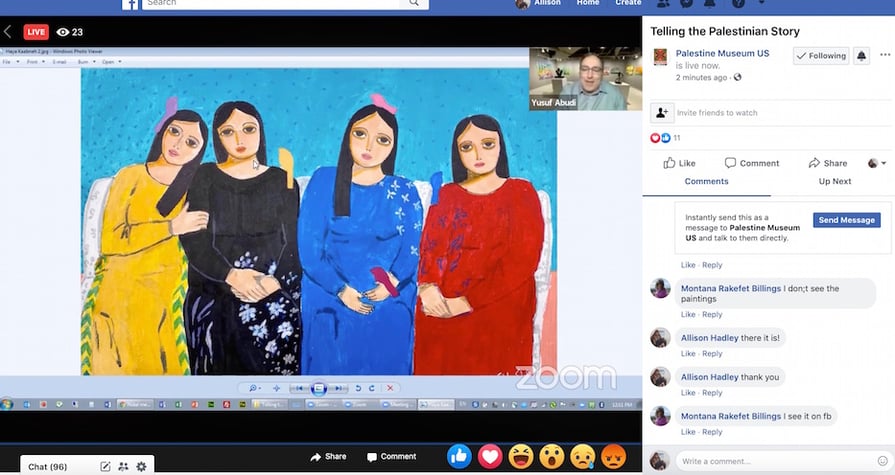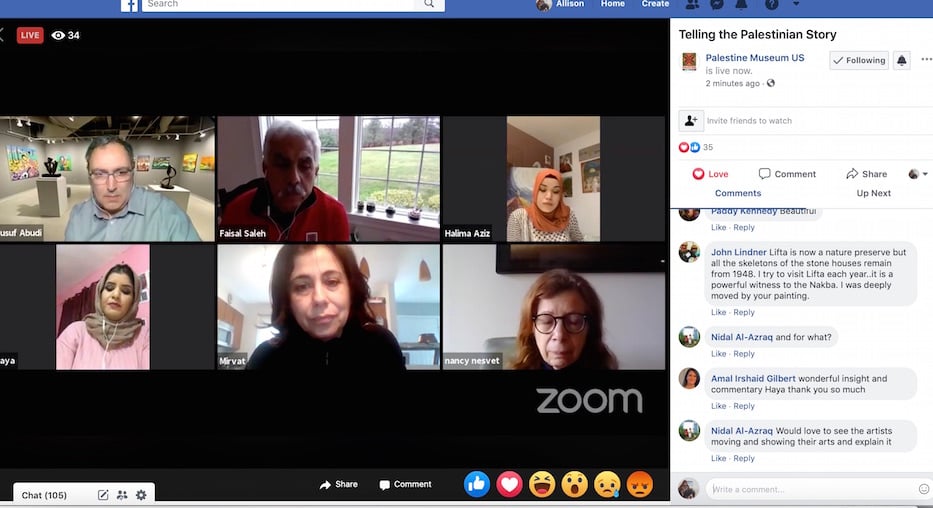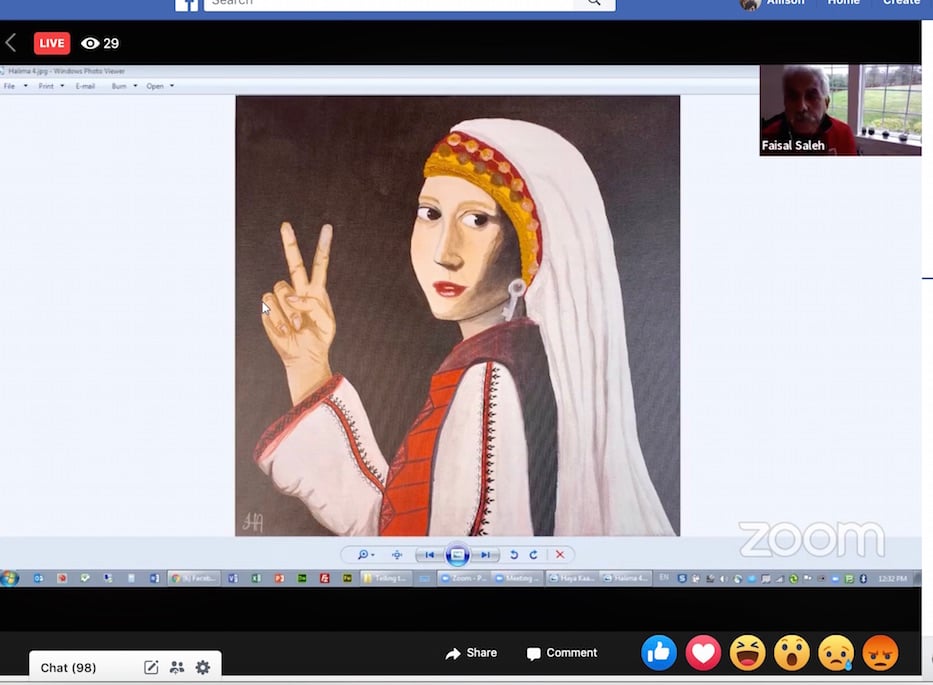
Haya Kaabneh, Women of Palestine, 2018. Acrylic on paper. Screenshot is from Facebook; the piece is on exhibition at the museum, which is currently closed to the public due to COVID-19.
Barbed, organic shapes ensnare bright pops of pigment while earth tones flow through negative space. A girl with a pearl earring—or is it a key?—gives a peace sign. Four women in bright dresses sit still and somber with steely-eyed gazes. Small birds perch on their shoulders, heads, and wrists, collecting like dust.
These are just a few of the images to emerge from Telling the Palestinian Story, a kaleidoscopic survey of 50-plus Palestinian women artists and over 200 contemporary works at the Palestine Museum in Woodbridge. Sunday afternoon, museum founder Faisal Saleh held an online discussion with curator Nancy Nesvet, moderator Yusuf Abudi, and artists Haya Kaabneh, Halima Aziz, and Rana Affo Bishara.
Kaabneh and Bishara are both based in Palestine; Aziz now lives in Dortmund, Germany. Originally, the exhibition was scheduled to run from March 8—International Women’s Day—through May 30. With months-long closures due to COVID-19, the museum has moved artist talks, virtual tours and programming all online. The museum has scheduled further hour-long artist talks each Sunday from noon to 1 p.m., Eastern Time.
As they tested the system Sunday, artists all met in the same virtual space, their faces filling the screen. A few technological kinks–a microphone feeding back here, a lagging Wi-Fi connection there—served to remind viewers of the collective circumstances under which they had gathered. As each of the artists spoke, a theme emerged.
From the outside, Palestine as a place or an idea can seem pallid and monolithic, populated with images polarized and heavy with conflict. But for artists that have called Palestine home, it is a place injected with the intoxicating cocktail of nostalgia, consternation and fondness. In other words, what the concept home evokes in anyone who's had one.
Haya Kaabneh is a young painter who began her art practice in earnest only two years ago. She said she was inspired to give voice to the stories of her relatives and neighbors, the women in her life who continue to seek liberation. As she spoke, she painted an image of a world that concentrically oppresses Palestinian women for both their woman-ness and their Palestinian-ness.
Perhaps, she suggested, it might occur to a motivated upstart to wade into their practice through acrylics or oil. Both media allow artists to model forms incrementally closer to their ideal while perfecting their technique. Kaabneh, however, chose watercolor. She explained that she initially settled on the medium because of, not in spite of, its notorious difficulty.
"When you paint with watercolor, once you have applied the paint it is very difficult to change,” she said. She likened it to the difficulty Palestinian women face in trying to change the course of their lives under the thumb of a patriarchal society, which itself is under the thumb of an oppressive political regime.

Clockwise from top: Board member and moderator Yusuf Abudi, Palestine Museum Founder Faisal Saleh, artist Halima Aziz, curator Nancy Nesvet, panelist, artist Haya Kaabneh.
She now has a pair of watercolor paintings in the exhibition. Together they form a dichotomous diptych with competing dark and light backgrounds. Each portrays seated women, all of whom are rendered in colorful traditional dress. In each, birds (black and polychromatic, respectively) perch confidently upon the women. The diptych's innocence belies the complexities hiding behind their stoic expressions.
Kaabneh is far from alone in seeing Palestine—and the Palestinian story—as kaleidoscopic. In one of her works, Aziz has riffed on a 1936 poster by artist Franz Krausz originally intended to attract Eastern European Jews to settle Palestine. In the original, Krausz has rendered the city in sun-soaked colors, viewed from above on a hill. The Dome of the Rock beckons from afar.
In her adaptation, Aziz depicts a sky of disembodied eyes above the Dome. At mid-distance, there is a concrete wall plastered with graffiti. In the foreground one sees a weary elderly couple, their bodies slightly obscured by robes. She has kept the signature text at the bottom—a suggestion to “Visit Palestine.”
The work is clever, complex and incisive, visually and conceptually arresting. Other works of hers include a "Palestinized" version of Johannes Vermeer’s Girl with the Pearl Earring, with Palestinian garb and a key for an earring. She uses sly, subtle alterations or her subjects to inject her work with meaning and touch of levity.

Halima Aziz, Palestinian Girl with a Key Earring, 2018. Acrylic on canvas. Screenshot is from Facebook; the piece is on exhibition at the museum, which is currently closed to the public due to COVID-19.
The longest practicing of the artists, Bishara leans most heavily on abstraction to convey her complex nostalgia for her homeland. Like Kaabneh, she relies on the symbolic meaning of medium, choosing to employ traditional Henna, with its feminine connotations and familiar scent.
Her work, however, relies on the recurring image of the cactus, with its infinitely reproducible form suggested as tightly or loosely as Bishara wishes.
To her, she explained Sunday, the cactus is the owner and cultivator of her vast ancestral lands. With their sturdy resilience, hardened exterior, sharp spines and sweet fruit, cactuses convey the harsh complexities of Palestine. Where villages, now destroyed, once stood, the plants stand in their place.
They are, as the artist described them, "the last witnesses.” She spoke of her subjects with a contagious glee, compelling viewers even deeper into her opaque and mysterious imagery.
In all, the conversation lasted a fleeting hour. Saleh will return next week with more artists, to present another hour-long chapter of Telling The Palestinian Story. For more information visit the museum on social media or at its website.